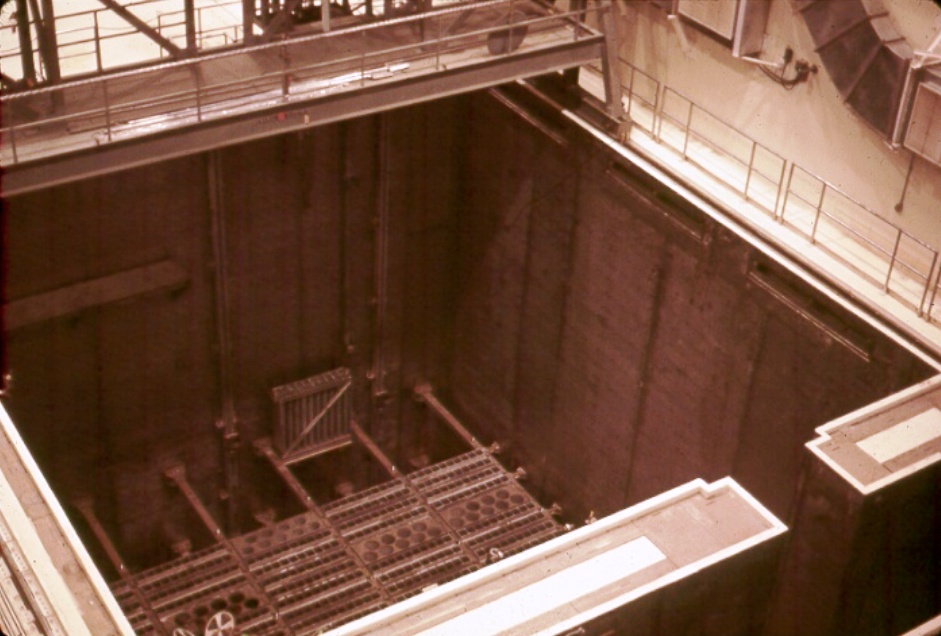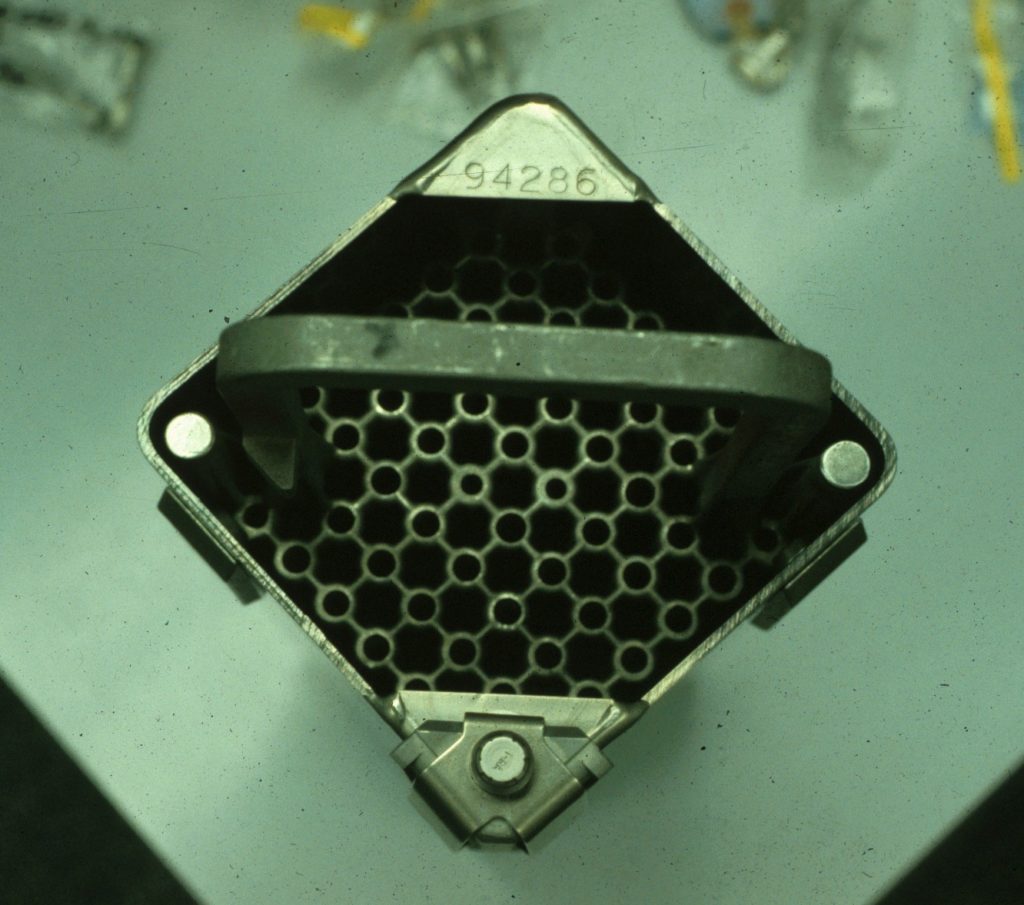Fission Stories #189
The previous two Fission Stories commentaries (#187 and #188) described problems at the Grand Gulf Nuclear Station near Port Gibson, Mississippi involving new fuel bundles stored in the new fuel vault and later in transferring them into the spent fuel pool. This post caps the trilogy by describing a problem encountered with the new fuel bundles in the spent fuel pool.
I was the reactor engineering supervisor at Grand Gulf as Unit 1 approached its first refueling outage. We had received the new fuel bundles to be loaded into the reactor core during the outage, inspected them, stored them temporarily in the new fuel vault, and transferred them into the spent fuel pool. During refueling, workers would transfer spent fuel bundles from the reactor core to the spent fuel pool and replace them with the new fuel bundles.
Figure 1 shows the spent fuel pool at Grand Gulf before it was filled with water and the new fuel bundles. A portion of the storage rack appears in the bottom of the picture. The fuel handling platform spans the spent fuel pool to the upper left. A boom traverses the platform and extends down into the pool to latch onto individual fuel bundles. The gate between the spent fuel pool and the transfer canal is in the lower right corner.
Workers manipulate the fuel handling platform to move a new fuel bundle, one at a time, underwater through the gate into the transfer canal. The bundle is placed inside a device called an upender. Workers operate the upender to lower the fuel bundle from the vertical to the horizontal position. A transfer cart transports fuel bundles through a hole in the containment wall to another pool. Another upender raises the fuel bundle to the vertical position. Another fuel handling platform and boom moves the fuel bundle from the upender into the reactor core. This process is reversed to move a fuel bundle from the reactor core to the spent fuel pool.
Preparing to load the reactor core
Fuel bundles are placed into specific locations and orientations within the reactor core. Extensive administrative controls are applied to fuel movements to ensure the correct fuel bundles are moved from proper location A to proper location B.
Senior management at Grand Gulf directed me to implement an additional administrative control. They directed me to verify the correctness of the map we had showing locations of the new fuel bundles in the spent fuel pool. If there were any mistakes, senior management wanted them identified and corrected then rather than during the refueling outage when time was more critical.
The top end of a dummy fuel bundle is shown in Figure 2. This dummy fuel bundle is the same size and is made of the same materials as a real fuel bundle. But its fuel rods are empty whereas real fuel rods are filled with fuel pellets made from uranium dioxide.
Although difficult to discern in the picture, the uppermost portion of a fuel bundle is a u-shaped part called the bale handle. The boom on the fuel handling platform latches onto the bale handle so that the fuel bundle can be lifted and moved from place to place from time to time. This dummy fuel bundles does not have it, but the bale handle on a real fuel bundle as a unique identifier—typically a multiple character string of letters and numbers like LJ505—engraved into it.
Verification of the spent fuel pool involved checking the bale handle IDs of fuel bundles in the storage rack against a map showing where they were supposed to be positioned. Any discrepancies would be resolved before the refueling outage. The verified map would be used to develop the sequence of movements necessary to move the new fuel bundles into the reactor core.
I assigned two reactor engineers to verify the spent fuel pool. They soon returned to my office and reported being unable to start the verification. When I asked why, one said it would be better to see it than hear it since I wouldn’t believe it either way. So, we walked up to the refueling floor.
Extreme painting
As background, Grand Gulf took measures to reduce the radioactive contamination within the plant. One of the measures called for painting structures and coating concrete surfaces to fill in cracks and crevices where radioactive particles could hide. Grand Gulf had a very aggressive paintings and coatings program. A joke at Grand Gulf cautioned workers against standing still too long while waiting for the elevator in the auxiliary building or they’d be painted.
The fuel handling platform and the railings around the spent fuel pool had been recently repainted. The operators turned off the spent fuel pool cooling and cleanup system and the refueling floor ventilation system as workers sprayed paint onto these structures. “Wet Paint” signs were still taped to the railings as we walked across the refueling floor to the edge of the spent fuel pool.
Looking down into the pool, I could not see the storage racks yet alone the bale handles of fuel bundles stored in them. The surface of the spent fuel pool was coated by a thick enough layer of paint that it obscured everything underneath. Grand Gulf’s aggressive painting and coatings program charted new ground—it had literally painted water.
We could not turn on the spent fuel pool cooling and cleanup system. Doing so would quickly clog the system’s filter unit with the paint. We’d only swap one problem for another.
We could not turn on the refueling floor ventilation system. Doing so would spread the stuff to other places it should not visit. Again, we’d only swap one problem for another.
We could not tie a rope about the painting and coatings program supervisor’s feet and dip into the pool to blot up the paint as one of my reactor engineers suggested. Doing so would work, but we retained it for Plan B.
Instead, we wrote a work order to have maintenance workers carefully scoop off the surface layer of paint from the pool.
Once the spent fuel pool water was unpainted, we verified that all fuel bundles were in the correct storage rack locations.
Our Takeaway
When given the assignment by senior management to verify the spent fuel pool, I thought it an unnecessary task. After all, we’d verified it once when transferring the fuel bundles from the new fuel vault. And we’d verified it a second time during the semi-annual verification of all special nuclear material onsite. There was no credible means for the fuel bundles to get mis-positioned in the spent fuel pool, so these two prior verifications should remain valid. But there was no credible excuse to provide senior management for not doing the additional check, so we undertook it.
While the additional check didn’t reveal mis-positioned fuel bundles, it did identify a spent fuel pool problem that could have gotten worse. The paint layer on the pool’s surface could have fouled the spent fuel pool cooling system and/or the refueling floor ventilation system. Or, it could have broken up and drifted down to foul the new fuel bundles.
So, the exercise taught me two things. First and most importantly, I learned that water could be painted. I knew that food coloring could be used to change water’s color, but I’d not known that water could be painted. I’ve heard about waterpainting, but knew enough to understand it was something entirely different. I’ve yet to learn why you’d want to paint water, but there’s still time for new lessons.
Second, I learned or re-learned that efforts can yield collateral benefits. Even if the spent fuel pool water had not been painted, re-verifying the spent fuel pool would have reaped dividends. Grand Gulf had not yet experienced a refueling outage. None of my reactor engineers had ever worked through a refueling outage. Re-verifying the spent fuel pool provided more of them with experience performing tasks they would replicate during the refueling outage. That effort supplemented their classroom training and procedure reading, making them better prepared for the refueling outage.
Fixing the painted spent fuel pool water was the tangible benefit from the exercise. Providing worker with more hands-on experience was the intangible benefit. Both were equally important outcomes.
“Fission Stories” is a weekly feature by Dave Lochbaum. For more information on nuclear power safety, see the nuclear safety section of UCS’s website and our interactive map, the Nuclear Power Information Tracker.


